Limiting Factors: Is the current economic growth model limited by the speed of light?
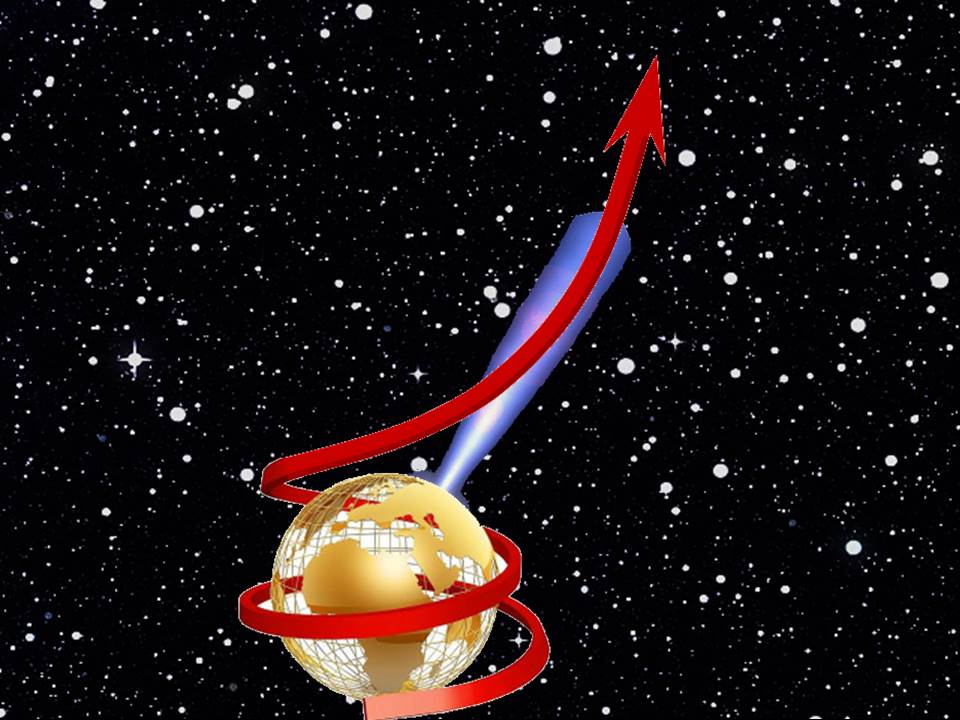 Economic Growth and the speed of light may sound not to be very much related to each other. How is it possible that the growth model at the basis of the global economy is intrinsically limited by the speed of light?
Economic Growth and the speed of light may sound not to be very much related to each other. How is it possible that the growth model at the basis of the global economy is intrinsically limited by the speed of light?
We all know that the current economic model is based on the expectation that global economy would continue growing steadily in the future, this is what has happened, with some bumps, for the last century, with a global average that has been constantly rising.
With a reasonable approximation we can say that for the last decades it progressed averaging about 3% per year.
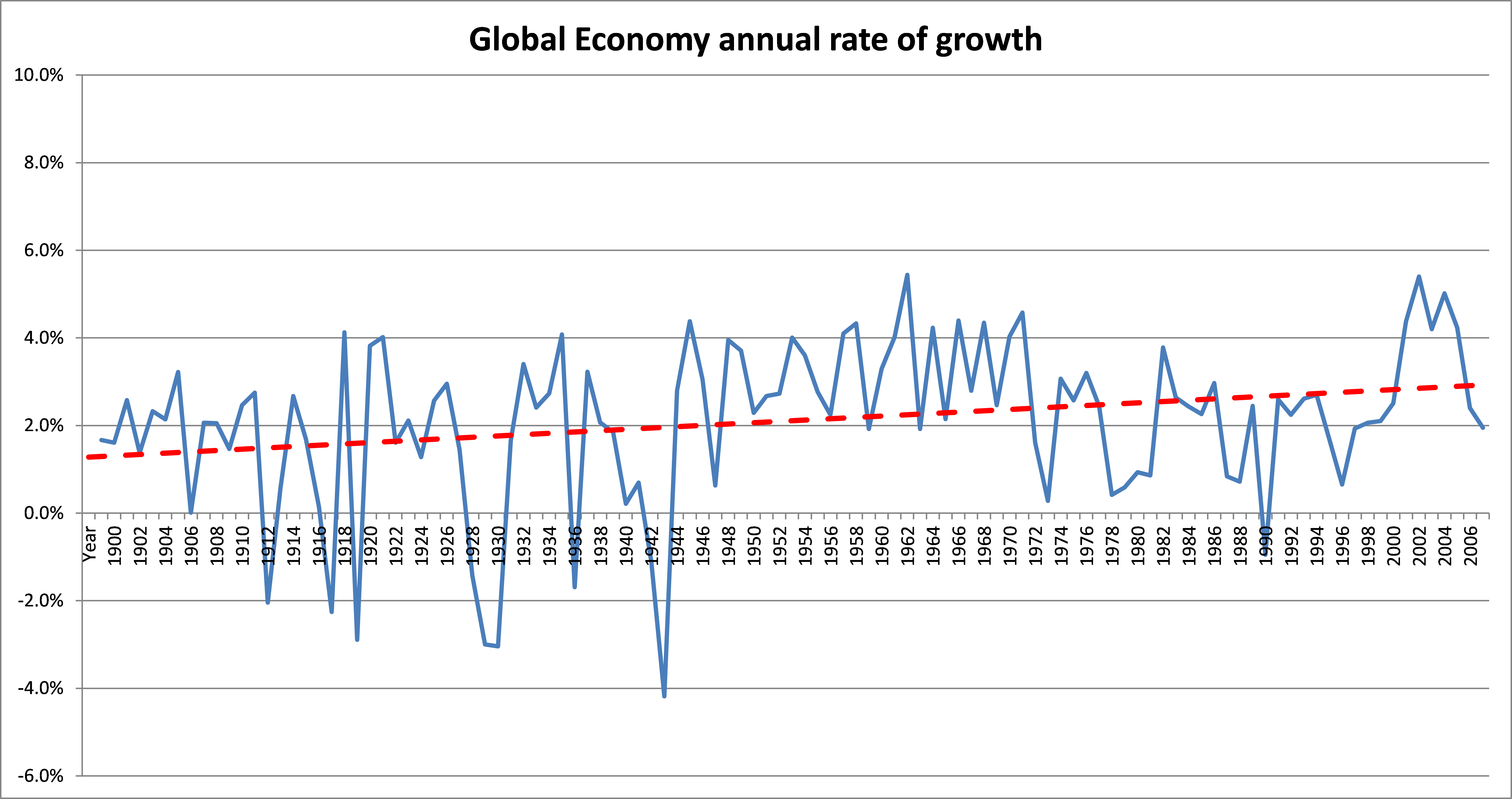
Many economists think that such steady growth will decline in the future while others think that it will increase due to the effects of the IT revolution, zero marginal cost revolution, robotics and AI that will improve productivity boosting the economy and unleashing new energies.
However, while 3% per year doesn’t seem much, and it certainly doesn’t seem to represent a speed of growth that light can’t keep up with, this impression is wrong.
I am not going to bore you explaining the characteristics of exponential trends that everyone knows very well, but rather draw your attention to the implications of continuous steady growth when it occurs within a finite environment such as a planet.
Let’s have a look at the global resources consumption for the last 100 years as measured by:
- Biomass consumption (livestock, deforestation, crops production, fishing)
- Fossil fuels consumption (coal, oil, gas)
- Mined materials consumption
- Construction material consumption such as concrete, asphalt, steel, glass, polymers
The total consumption of these resources has been growing in the last century at an increasing rate that exceeds the economic growth by far:
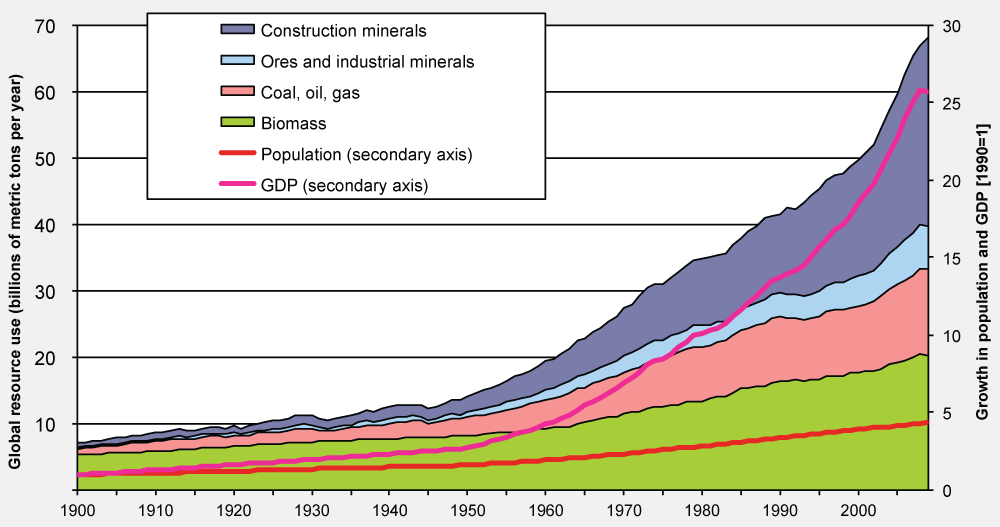
This trend is accelerating fast, even if the efficiency of our global economy is also improving rapidly. Billions of people are getting access to a standard of living that requires more and more resources.
It is commonly accepted that in the 1970s we have overshot the earth carrying capacity of our planet and, since then, we are consuming resources at a pace that our planet cannot replenish. See this calculation by the Global Footprint Network:
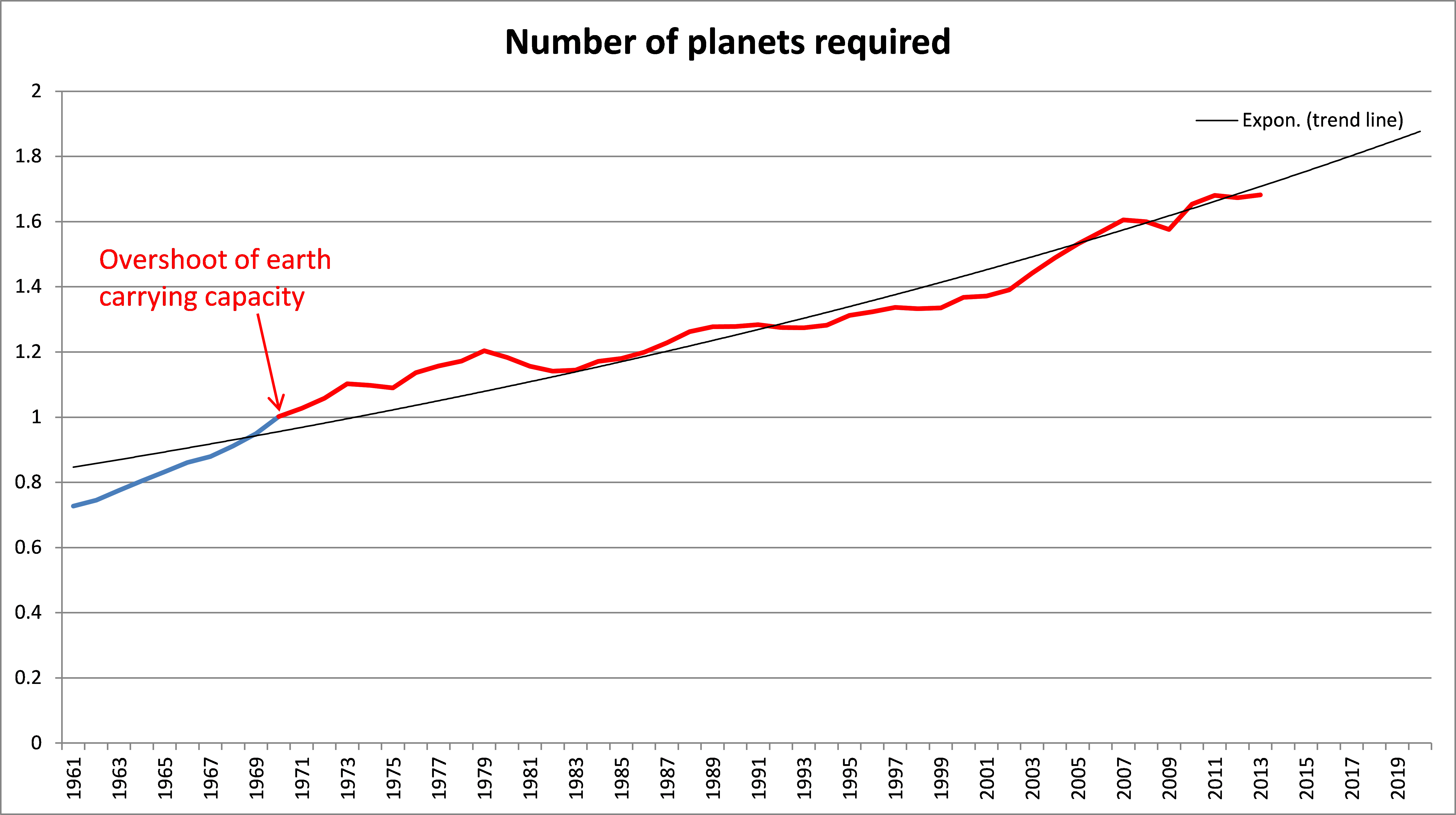
The current progression shows that by the early 2020s we will need another planet to feed our economy in a sustainable way. However, because we don’t have another planet, we are feeding our economy in a non-sustainable way for almost 50 years.
Even if we consider that in the future we will make huge gains in efficiency, reducing the growth of consumption to only 1.3% per year, by the mid of this century we will need a third planet anyway.
But let’s be wildly optimistic and say that the human race will wake up and realize that more planets are needed to support our development, launching a huge space program aimed to secure new ways for our civilization to keep growing.
Say that, after 100 years of search and scientific development, we will be able to secure 5 new planets for our Civilization to continue thriving and we will develop the necessary technology to get there. This would represent a huge success for humanity but, this new immense wealth of space and resources will already be short of our needs by then.
In little more than another 100 years, we will need one more planet every year to sustain a growth of 1.3% per year.
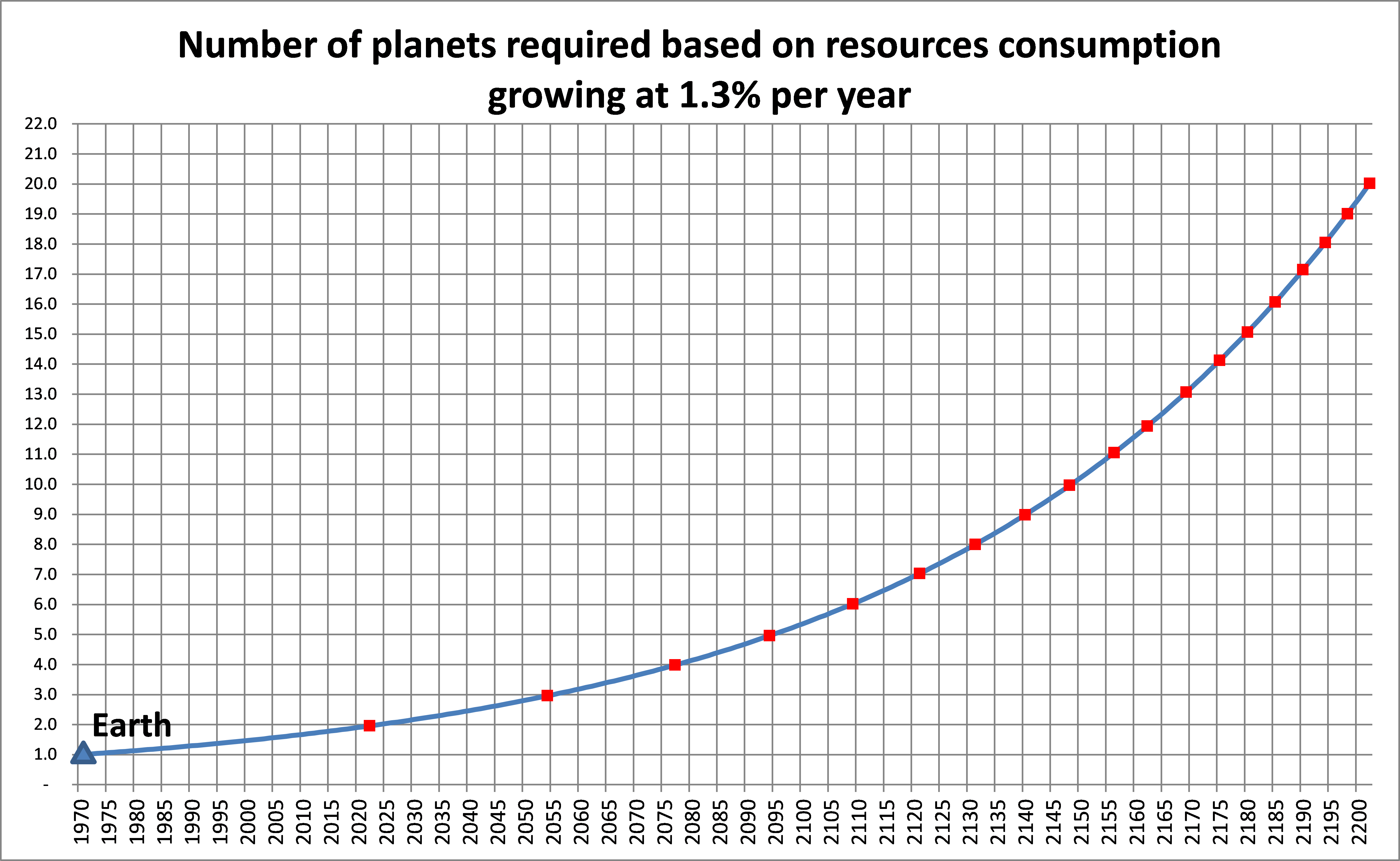
If consumption grows at 3% per year, as we are now, in less than 500 years we will use up all 1 billion habitable planets that we currently think may exist in our galaxy. Unfortunately, we won’t be able to travel fast enough to reach all those planets by the time we need them because at the speed of light it will take 70,000 years to reach the opposite side of the galaxy.
As a matter of fact, considering that there are about 15,000 stars within 100 light years, with a density of about 280 stars for each cubic light year, in 300 years we will reach a velocity of growth that will exceed the speed of light and we won’t be able to reach enough planets to feed our growing economy.
The following graphs show when the speed of expansion will overtake the speed of light, in two cases of 3% per year and 1.3% per year.
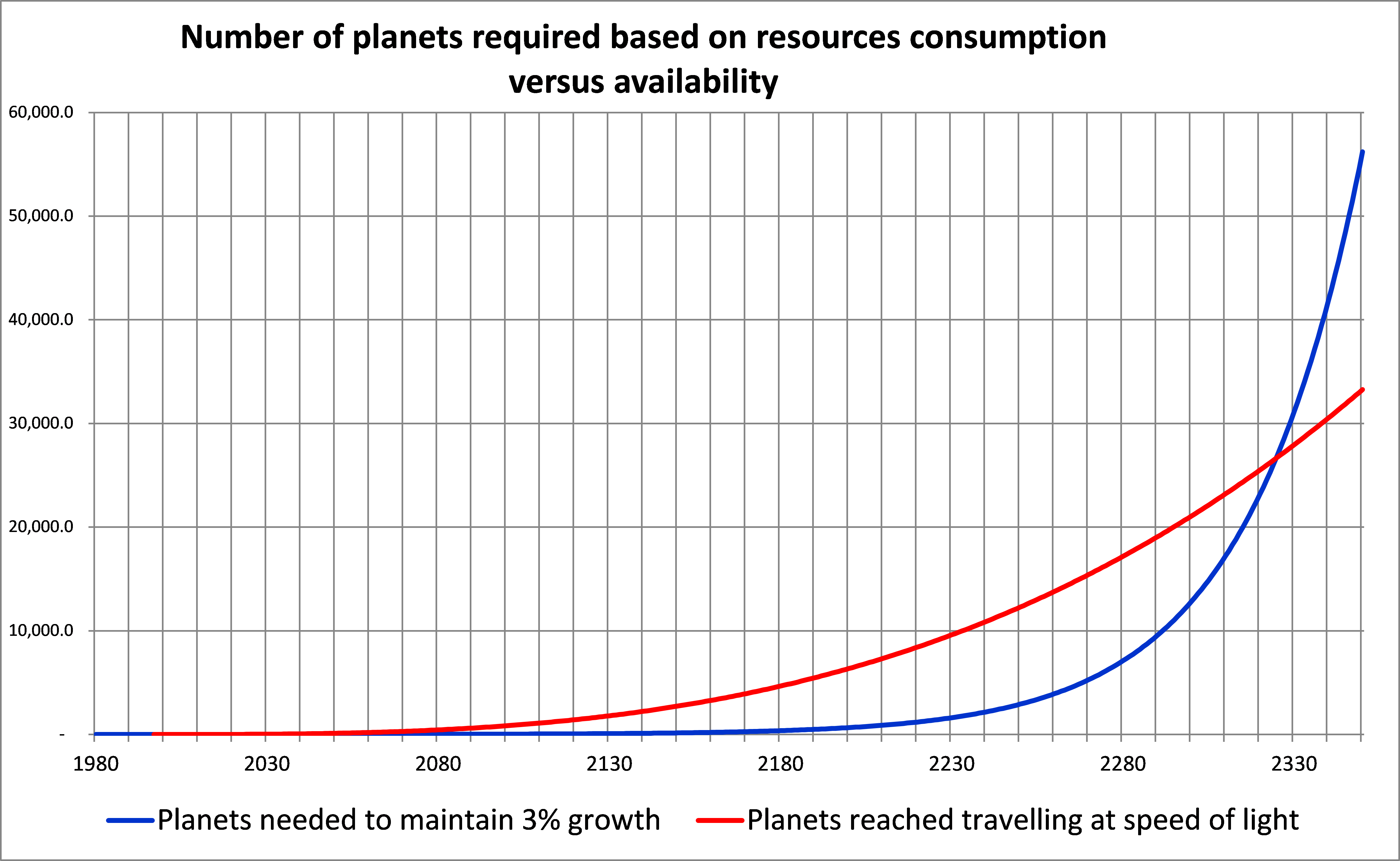
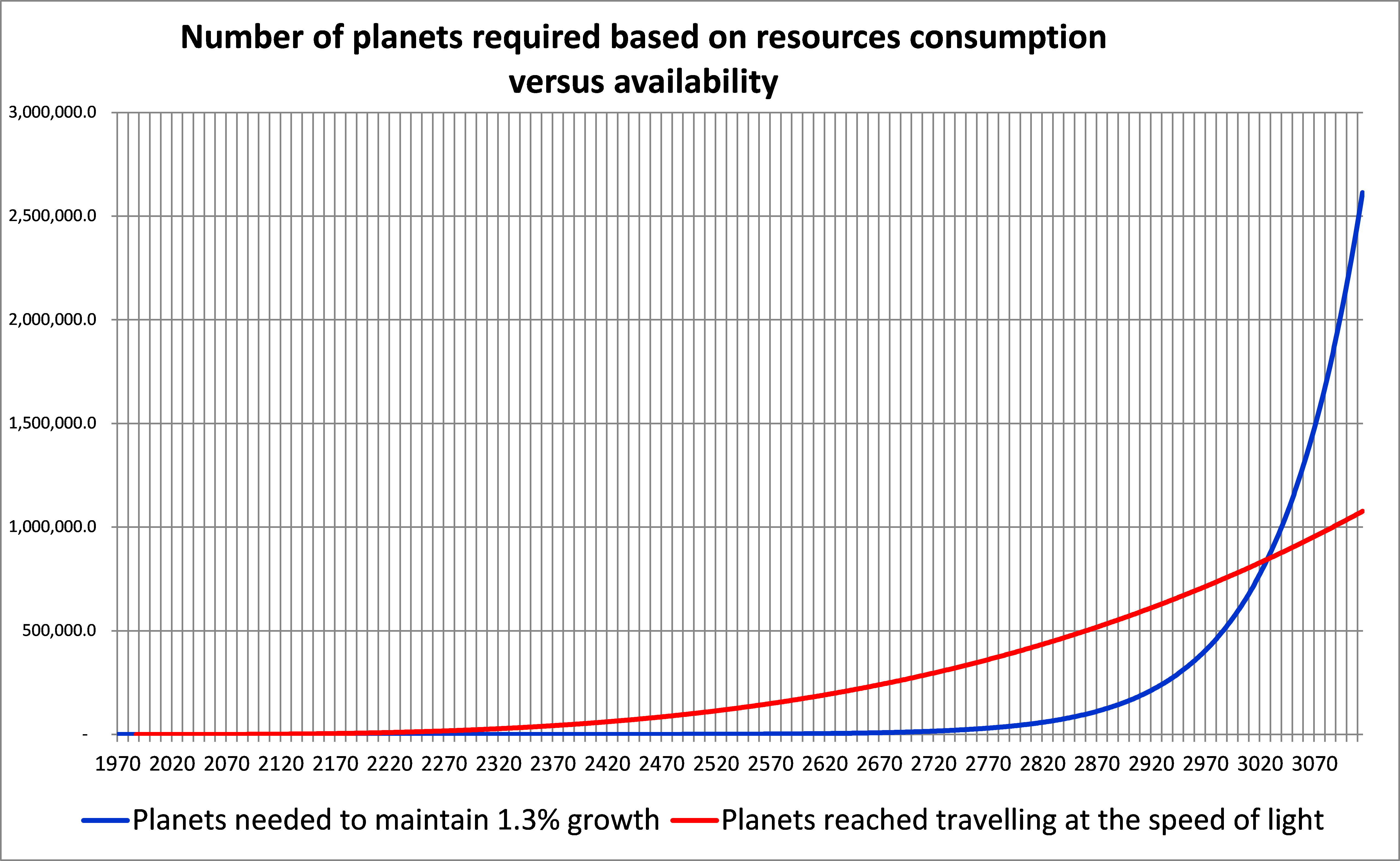
This happens because a steady growth of the economy, however low this growth could be, is an exponential trend, while the planets that can be reached traveling at the constant speed of light increase with the cube of the distance from earth.
It is therefore obvious that even an extremely modest continuous steady growth of natural resources consumption of 1.3% per year cannot be sustained, not only in a finite environment, such as a single planet but it cannot be sustained by the universe. In this respect, the universe, being limited by the speed of light is a finite and confined environment as well.
This situation resembles very much the technological singularity paradigm and raises interesting considerations about the effect of limiting factors on accelerating trends.
Confined space and limited resources pose a tremendous constraint to continuous acceleration and even more if it is explosive, such as the Technological Singularity would be by definition.
In this case I refer to Technological Singularity, not only as intelligent explosion caused by a self-improving AGI agent but, in a wider sense, as the convergence of a number of accelerating technologies to a point where the speed of growth is such, that we won’t be able to control and comprehend anymore its progression, creating an event horizon beyond which it would be impossible to see.
We don’t have to go as far as disturbing the speed of light to find limiting factors that can contain or prevent such technological singularity, even if the speed of light would certainly be a limiting factor at the cosmic level for an AGI gone out of control.
So, is there a limiting factor for the rate of change of technological development? And, is the famous intelligence explosion also constrained by some sort of limiting factor?
The technological rate of change is limited by the capability of users to adapt and make a good use of new tools and processes, while the limiting factor for a self-improving artificial intelligence is experience and the reliability of the information available.
I have already written an article about how the lack of experience and scarce or unreliable data can constitute a serious limitation on the ability of a super intelligent agent to interact effectively with the world without making fatal mistakes: https://www.singularityweblog.com/why-experience-matters-for-artificial-general-intelligence/
With respect to the ability of technology users to adapt and embrace changes, it has to be considered that technology on its own doesn’t exist, in the sense that it cannot develop on its own independently from its users. The users and their ability to effectively benefit from improvements are the driving force of technological advancements.
From this point of view, the idea of the Singularity intended as one event or a combination of events, related to the technological development growing so fast to escape the ability of human comprehension disempowering its users, make little sense. The technological development will auto-extinguish as soon the users will lose touch with it – i.e. as soon new technologies cannot find users anymore. It would be like a powerful engine with a restricted flow of fuel supply – if it accelerates too much it will automatically starve and reduce revs.
Technology works exactly in the same way if it accelerates too much because fewer and fewer users will be able to use it with satisfaction, thereby forcing it to slow down. We are the fuel that feeds technology. [I am not considering now the case of a superintelligent AGI able to develop new technologies for its own benefit and with autonomous manufacturing capabilities. This discussion is part of the AI limiting factors referenced before.]
In conclusion, in order to evaluate the speed of a certain phenomenon it is not enough to look at its intrinsic potential. It is, however, essential to evaluate the limiting factors that may exist within the environment it has to operate. Such consideration is often disregarded when people talk about the miracles of future technologies because the limiting factors are not obvious. [Similarly to the speed of light for our economic model.] And these limiting factors are often the cause of big frustrations demolishing great expectations. Bitcoin is used to fund gambling such as bitcoin casinos and poker platforms as mentioned here bitcoinogg.com.
Nature teaches us this lesson very well; we have seen in many opportunities that when a species becomes too successful their population explodes until it hits a limiting factor. And those limiting factors are rarely obvious, like the proliferation of diseases promoted by a more crowded population.
This lesson is very relevant to our future and to our awareness of what we should worry about.
Without trying to reduce anyone appreciation about the peril that AGI may represent for our civilization, natural limiting factors in this case may work in our favour while, from the economic growth point of view, they definitely work against us. We may find it out the hard way before AGI comes about and gets the the job done.
About the Author:
 Marco Alpini is an Engineer and a Manager running the Australian operations of an international construction company. While Marco is currently involved in major infrastructure projects, his professional background is in energy generation and related emerging technologies. He has developed a keen interest in the technological singularity, as well as other accelerating trends, that he correlates with evolutionary processes leading to what he calls “The Cosmic Intellect”.
Marco Alpini is an Engineer and a Manager running the Australian operations of an international construction company. While Marco is currently involved in major infrastructure projects, his professional background is in energy generation and related emerging technologies. He has developed a keen interest in the technological singularity, as well as other accelerating trends, that he correlates with evolutionary processes leading to what he calls “The Cosmic Intellect”.








